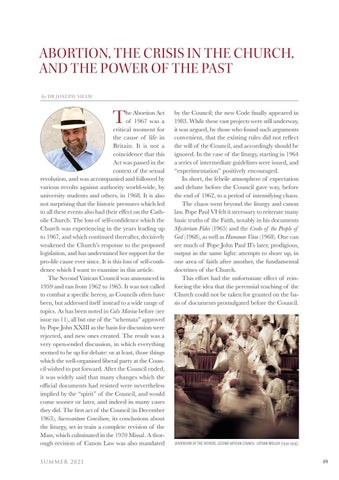ABORTION, THE CRISIS IN THE CHURCH, AND THE POWER OF THE PAST by DR J O S E P H S H AW
T
he Abortion Act of 1967 was a critical moment for the cause of life in Britain. It is not a coincidence that this Act was passed in the context of the sexual revolution, and was accompanied and followed by various revolts against authority world-wide, by university students and others, in 1968. It is also not surprising that the historic pressures which led to all these events also had their effect on the Catholic Church. The loss of self-confidence which the Church was experiencing in the years leading up to 1967, and which continued thereafter, decisively weakened the Church’s response to the proposed legislation, and has undermined her support for the pro-life cause ever since. It is this loss of self-confidence which I want to examine in this article. The Second Vatican Council was announced in 1959 and ran from 1962 to 1965. It was not called to combat a specific heresy, as Councils often have been, but addressed itself instead to a wide range of topics. As has been noted in Calx Mariae before (see issue no 11), all but one of the “schemata” approved by Pope John XXIII as the basis for discussion were rejected, and new ones created. The result was a very open-ended discussion, in which everything seemed to be up for debate: or at least, those things which the well-organised liberal party at the Council wished to put forward. After the Council ended, it was widely said that many changes which the official documents had resisted were nevertheless implied by the “spirit” of the Council, and would come sooner or later, and indeed in many cases they did. The first act of the Council (in December 1963), Sacrosantum Concilium, its conclusions about the liturgy, set in train a complete revision of the Mass, which culminated in the 1970 Missal. A thorough revision of Canon Law was also mandated S UM ME R 2 021
by the Council; the new Code finally appeared in 1983. While these vast projects were still underway, it was argued, by those who found such arguments convenient, that the existing rules did not reflect the will of the Council, and accordingly should be ignored. In the case of the liturgy, starting in 1964 a series of intermediate guidelines were issued, and “experimentation” positively encouraged. In short, the febrile atmosphere of expectation and debate before the Council gave way, before the end of 1962, to a period of intensifying chaos. The chaos went beyond the liturgy and canon law. Pope Paul VI felt it necessary to reiterate many basic truths of the Faith, notably in his documents Mysterium Fidei (1965) and the Credo of the People of God (1968), as well as Humanae Vitae (1968). One can see much of Pope John Paul II’s later, prodigious, output in the same light: attempts to shore up, in one area of faith after another, the fundamental doctrines of the Church. This effort had the unfortunate effect of reinforcing the idea that the perennial teaching of the Church could not be taken for granted on the basis of documents promulgated before the Council.
DISPERSION OF THE FATHERS, SECOND VATICAN COUNCIL. LOTHAR WOLLEH (1930-1979).
49











